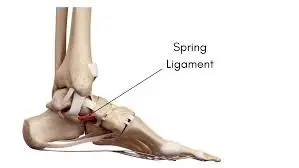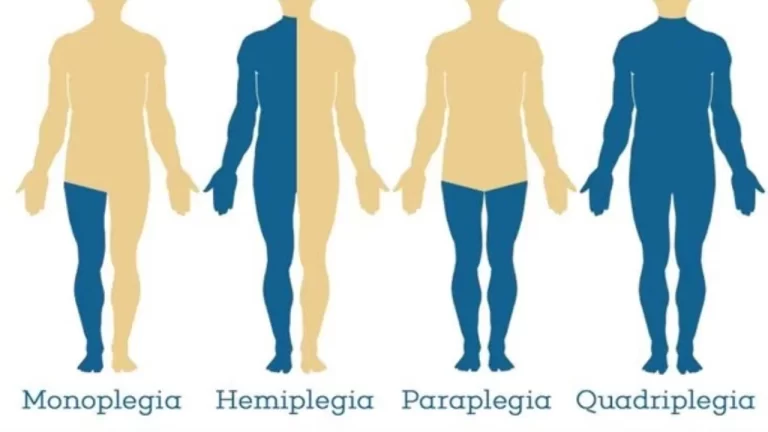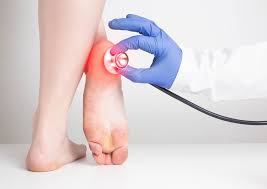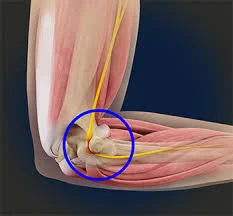Spring Ligament Tear
Introduction:
A spring ligament tear refers to damage to the plantar calcaneonavicular ligament, a key structure in the foot that supports the arch and stabilizes the midfoot. This ligament connects the heel bone (calcaneus) to the navicular bone.
A tear can result from trauma or chronic stress and often leads to pain, swelling, and flattening of the arch, sometimes contributing to flatfoot deformity.
Clinical Relevance Anatomy:
A functional loss of the posterior tibial tendon increases the stresses on the medial soft tissue structures of the foot, including the spring ligament, which may cause their attenuation and the development of acquired flat foot deformity.
According to Deland and colleagues’ analysis of MRI results in patients with posterior tibial tendon insufficiency, 74% of patients were diagnosed with a spring ligament tear, and all patients had some degree of spring ligament attenuation.
Although dysfunction of the posterior tibial tendon is the primary cause of flat foot deformity, it should be highlighted that the deformity cannot be caused just by the posterior tibial tendon; the medial soft tissue structures must also fail in order for the deformity to occur.
Causes of Spring Ligament Tear:
- Flatfoot Deformity (Posterior Tibial Tendon Dysfunction)
- Trauma or Injury
- Overuse or Repetitive Stress
- Obesity
- Age-Related Degeneration
- Abnormal Foot Mechanics
- Previous Foot or Ankle Injuries.
Symptoms of Spring Ligament Tear:
- Pain in the Foot or Ankle
- Swelling and Tenderness
- Flattening of the Foot Arch
- Difficulty Walking or Standing for Long Periods
- Foot Instability
- Visible Deformity
- Pain Worsens with Activity.
Differential diagnosis:
- Posterior tibial tendon injury
- Congenital flatfoot
- Midtarsal sprain
- Deltoid ligament injury
- Accessory navicular syndrome.
Diagnosis:
- Plain radiograph: Hindfoot valgus or a flat foot deformity may be visible on plain radiography. The lateral talo-first metatarsal angle can be evaluated for flat foot deformity using weight-bearing x-rays of the foot.
- Ultrasound: There may be thickening of the superomedial calcaneonavicular ligament, along with increased vascularity and a lack of the typical fibrillar echo pattern. Signs of posterior tibial tendinopathy may be present.
- MRI: Ligament thickening or thinning, irregularities in contour, inhomogeneity, partial or complete discontinuity, and changes in signal intensity, particularly on fat-suppressed T2-weighted or intermediate weighted sequences of one or more of the three ligamentous components, are imaging features of a plantar calcaneonavicular injury, just like in other ligament injuries. Indirect indicators could also exist, such as the posterior tibial tendon making direct contact with the talar head.
Treatment of Spring Ligament Tear:
The degree of the damage and clinical symptoms determine management. Patients with low-grade sprains or partial tears who have no or few foot abnormalities and a low chance of further advancement should get conservative treatment, which includes boots or orthotic devices that support the medial longitudinal arch.
A posterior tibial tendon stump, a peroneal or split tibialis anterior tendon graft, direct suture repair, or spring ligament reconstruction procedures with an anterior deltoid ligament graft are surgical alternatives.
Medical Treatment:
- Modification of Rest and Activity: Avoid free of weight-bearing exercises to lessen ligament strain.
- Ice Treatment: use ice to lessen pain and edema.
- Anti-inflammatory Drugs: NSAIDs.
- Arch Supports or Orthotics: insoles that are specially made to support the arch and lessen ligament strain.
- Bracing or Immobilization: To support the foot and promote recovery, walking boots or ankle braces may be utilized.
- Physical Therapy: exercises to improve foot biomechanics and strengthen surrounding muscles.
Prevention of Spring Ligament Tear:
Maintaining good foot health and reducing strain on the arch-supporting structures are key to preventing a spring ligament injury. It’s crucial to wear supportive shoes with enough cushioning and arch support, especially when engaging in intense activity. Custom orthotic inserts may be helpful for people with flat feet or atypical foot mechanics to improve alignment and lessen ligament strain.
Frequent strengthening exercises for the ankle and foot can improve stability and avoid ligament stress. Reducing excessive pressure on the foot also requires maintaining a healthy body weight. Avoiding overuse or abrupt increases in physical activity is also crucial, as is always warming up appropriately before exercising. For individuals who are at risk, early intervention and regular foot exams can help identify and treat small problems before they result in a rupture.
Complications of Spring Ligament Tear:
A spring ligament tear can result in several problems if it is not addressed or appropriately controlled. The most prevalent is progressive flatfoot deformity, in which the foot’s arch keeps collapsing, changing foot alignment and impairing gait.
The increased strain on the surrounding structures might result in persistent pain, especially along the inner side of the foot and ankle. It can also induce malfunction of the posterior tibial tendon. Joint deterioration, decreased mobility, and trouble carrying out daily tasks are all possible outcomes of the disorder over time. In extreme situations, surgery is required to reduce pain and restore function.
- Adult-acquired flatfoot deformity
- lateral hindfoot impingement
- Subtalar joint osteoarthritis.
Prognosis:
The severity of the injury and the promptness of treatment have a significant impact on the prognosis of a spring ligament tear. Many patients achieve significant pain alleviation and return to normal foot function with early diagnosis and proper conservative management, including physical therapy, orthotic support, and rest. However, surgery could be necessary to restore stability and alignment in more severe cases or when the tear is linked to a growing flatfoot deformity.
Overall, post-operative results are favorable, particularly when paired with appropriate rehabilitation. In general, most people may resume their normal activities with few long-term consequences if they follow the proper treatment.
Conclusion:
To sum up, a spring ligament tear is a serious disease that, if left untreated, can affect foot stability and general movement. It usually manifests as inner foot pain, edema, and arch collapse and is caused by trauma, overuse, or flatfoot deformity.
For the best recovery, an early diagnosis made by imaging and physical examination must be followed by the right conservative or surgical treatment. Injury risk can be significantly decreased by using preventive measures including orthotics, supportive footwear, and frequent strengthening exercises. Most people can recover completely and keep their feet healthy and useful with prompt care and rehabilitation.
FAQs:
What is the duration required to repair a spring?
Replacing the front coil springs takes between one to three hours, and replacing the rear coil springs takes about one to one and a half hours. It can take longer if there are any issues during the spring replacement process.
Is surgery necessary for a torn spring ligament?
Therefore, in addition to treating anomalies of the tibialis posterior tendon, the spring ligament should be corrected. Traditionally, significant soft-tissue dissection and an open technique are needed to repair the ligament. There have been recent reports of ligament repair by endoscopic means.
How does one feel when a spring ligament is torn?
Similar to posterior tibial tendon insufficiency, the clinical signs are ambiguous. These include early, hazy, activity-related medial foot and ankle pain, trouble walking on uneven terrain, and/or issues with balance.
When your ankle is sprained, what shoes should you wear?
Additional ankle support is provided by high-top footwear. They shorten the time it takes for the ankle to heal by restricting excessive foot movement. Choose shoes with high traction and hard soles.
Is it possible to sprain a ligament?
Bones are held together by strong, pliable ligaments. The region surrounding the joint will swell and hurt if a ligament tears or is overextended.
How much time does it take for a spring ligament to recover?
The degree of the damage affects how long it takes for the foot’s ligaments to mend. While more serious tears could take several months to fully heal, minor sprains might mend in a few weeks.
For what length of time should I avoid a sprained ankle?
The majority of ankle sprains heal with just a little rest. Four to six weeks are needed for the healing phase. To help you remember what to do, use the abbreviation R.I.C.E.
Which springtime injuries are the most prevalent?
Ankle sprains, groin pulls, hamstring strains, shin splints, knee problems, and Little League or tennis elbow are among the common springtime injuries. The most common cause of injuries is a lack of muscle and joint conditioning, and many of these injuries are avoidable.
How much time does it take for spring knee to heal?
The healing period for a sprained knee is often several weeks. It may take several months for more serious sprains.
How much time does a spring need to recover?
For up to eight weeks, stay away from intense exercise like jogging because there’s a chance of more harm. recovery from severe sprains and strains may take months.
How long does it take to recover after spring ligament surgery?
Your recovery time and the kind of work you undertake will determine this. Generally speaking, you should be able to resume work after two weeks if your work requires you to spend most of your time sitting down; if it requires manual labor, you could need to take eight to ten weeks off.
How are spring ligaments treated?
Physical therapy, rest, compression, ice, and anti-inflammatories are also used. More serious injuries might need to be repaired surgically. Nonoperative treatment for degenerative tears in older adults may involve rest, physical therapy, immobilization, and anti-inflammatory medications.
What occurs if your spring ligament is torn?
A flat foot deformity results from a failure of the plantar calcaneonavicular ligament, also known as the spring ligament. The plantar calcaneonavicular ligament is a broad, wide band of cartilaginous connective tissue that supports the foot’s medial longitudinal arch.
References
- Feger, J. (2021). Spring ligament complex injury. Radiopaedia.org. https://doi.org/10.53347/rid-90905
- Lui, T. H. (2017). Arthroscopic repair of superomedial spring ligament by talonavicular arthroscopy. Arthroscopy Techniques, 6(1), e31–e35. https://doi.org/10.1016/j.eats.2016.08.034
- ACUTE SPRING LIGAMENT-COMPLEX TEAR. (2005). In AJR (Vols. 184–1475, pp. 1475–1480) [Journal-article]. https://www.iop.net.au/media/k20ox3pd/acute-spring-ligament-complex-tear.pdf







